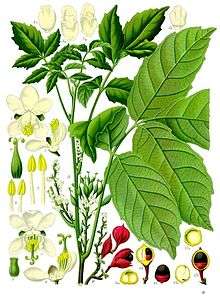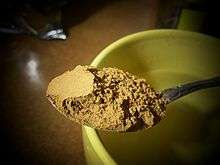Guarana
| Guaraná | |
|---|---|
 | |
| Scientific classification | |
| Kingdom: | Plantae |
| (unranked): | Angiosperms |
| (unranked): | Eudicots |
| (unranked): | Rosids |
| Order: | Sapindales |
| Family: | Sapindaceae |
| Genus: | Paullinia |
| Species: | P. cupana |
| Binomial name | |
| Paullinia cupana Kunth | |
Guaraná (/ɡwəˈrɑːnə/ from the Portuguese guaraná [ɡwaɾãˈna]), Paullinia cupana, syn. P. crysan, P. sorbilis) is a climbing plant in the maple family, Sapindaceae, native to the Amazon basin and especially common in Brazil. Guarana features large leaves and clusters of flowers, and is best known for the seeds from its fruit, which are about the size of a coffee bean. As a dietary supplement, guarana is an effective stimulant:[1] its seeds contain about twice the concentration of caffeine found in coffee seeds (about 2–4.5% caffeine in guarana seeds compared to 1–2% for coffee seeds).[2]
As with other plants producing caffeine, the high concentration of caffeine is a defensive toxin that repels herbivores from the berry and its seeds.[3]
The guarana fruit's colour ranges from brown to red and contains black seeds which are partly covered by white arils. The colour contrast when the fruit has been split open has been likened to eyeballs; which has formed the basis of an origin myth among the Sateré-Mawé people.[4]
History and culture
The word guarana comes from the Guaraní word guara-ná, which has its origins in the Sateré-Maué word for the plant, warana,[5] that in Tupi-Guarani means "fruit like the eyes of the people"
Guarana plays an important role in Tupi and Guaraní Paraguayan culture. According to a myth attributed to the Sateré-Maué tribe, guarana's domestication originated with a deity killing a beloved village child. To console the villagers, a more benevolent god plucked the left eye from the child and planted it in the forest, resulting in the wild variety of guarana. The god then plucked the right eye from the child and planted it in the village, giving rise to domesticated guarana.[6]
The Guaranís would make an herbal tea by shelling, washing and drying the seeds, followed by pounding them into a fine powder. The powder is kneaded into a dough and then shaped into cylinders. This product is known as guarana bread, which would be grated and then immersed into hot water along with sugar.[7]
This plant was introduced to European colonizers and to Europe in the 16th century by Oviedo, Hernández, Cobo and other Spaniard chroniclers. By 1958, guarana was commercialized.[7]
Composition
| Chemical component | Parts per million |
|---|---|
| Adenine | |
| Ash | < 14,200 |
| Caffeine | 9,100–76,000 |
| Catechutannic-acid | |
| Choline | |
| D-catechin | |
| Fat | < 30,000 |
| Guanine | |
| Hypoxanthine | |
| Mucilage | |
| Protein | < 98,600 |
| Resin | < 70,000 |
| Saponin | |
| Starch | 50,000–60,000 |
| Tannin | 50,000–120,000 |
| Theobromine | 200–400 |
| Theophylline | 0–2,500 |
| Timbonine | |
| Xanthine | |
The table contains a partial listing of some of the chemicals found in guarana seeds,[8][9] although other parts of the plant may contain them as well in varying quantities.
According to the Biological Magnetic Resonance Data Bank, guaranine (better known as caffeine) is found in guarana, and is identical to caffeine derived from other sources, like coffee, tea, and mate. Guaranine, theine, and mateine are all synonyms for caffeine when the definitions of those words include none of the properties and chemicals of their host plants except caffeine.[10] Natural sources of caffeine contain widely varying mixtures of xanthine alkaloids other than caffeine, including the cardiac stimulants theophylline and theobromine and other substances such as polyphenols, which can form insoluble complexes with caffeine.[11][12] The main natural phenols found in guarana are (+)-catechin and (-)-epicatechin.[13]
Uses


Guarana is used in sweetened or carbonated soft drinks and energy shots, an ingredient of herbal teas or contained in capsules. Generally, South America obtains most of its caffeine from guarana.[14]
Beverages
Brazil, which is the third-largest consumer of soft drinks in the world,[15] produces several soft drink brands from guarana extract. The Portuguese word guaraná is widely used in Brazil as a reference to soft drinks containing guarana extract. Popular brands include Guaraná Antarctica, Guaraná Jesus, and Kuat. Guarana is the branch of a popular energy drink in Serbia.
Rockstar, Monster, Bawls and Red Bull are also brands which contain guarana in some varieties.
Other uses and side effects
In the United States, guarana has received the designation of "generally recognized as safe" by the American Food and Drug Administration.[16]
Preliminary research has shown guarana may affect how quickly the body perceives itself to be full. One study showed an average 5 kg (11 lb) weight loss in a group taking a mixture of yerba mate, guarana, and damiana, compared to an average one-pound loss in a placebo group after 45 days.[17] Although inconclusive about specific effects due only to guarana, this study differs from another showing no effect on body weight of a formula containing guarana.[18]
Guarana extract reduced aggregation of rabbit platelets by up to 37 percent below control values and decreased platelet thromboxane formation from arachidonic acid by 78 percent below control values.[19] It is not known if such platelet action has any effect on the risk of heart attack or ischemic stroke.[20]
References
- ↑ Johannes, Laura (March 2, 2010). "Can a Caffeine-Packed Plant Give a Boost?". The Wall Street Journal. p. D3.
- ↑ Bempong DK, Houghton PJ, Steadman K (1993). "The xanthine content of guarana and its preparations". Int. J. Pharmacog. 31 (3): 175–81. doi:10.3109/13880209309082937. ISSN 0925-1618.
- ↑ Ashihara H, Sano H, Crozier A (February 2008). "Caffeine and related purine alkaloids: biosynthesis, catabolism, function and genetic engineering". Phytochemistry. 69 (4): 841–56. doi:10.1016/j.phytochem.2007.10.029. PMID 18068204.
- ↑ Prance G, Nesbitt M, eds. (2004). Cultural History of Plants. New York: Routledge. p. 179.
- ↑ "guarana". Merriam Webster. Retrieved 2007-09-18.
- ↑ Beck HT (2004). "10 Caffeine, Alcohol, and Sweeteners". In Ghillean Prance; Mark Nesbitt. Cultural History of Plants. New York: Routledge. p. 179. ISBN 978-0-415-92746-8.
- 1 2 Weinberg BA, Bealer BK (2001). The World of Caffeine: The Science and Culture of the World's Most Popular Drug. New York: Routledge. pp. 259–60. ISBN 978-0-415-92723-9.
- 1 2 "Guarana", Dr. Duke's Phytochemical and Ethnobotanical Databases, 2007-09-18, OCLC 41920916, retrieved 2007-09-18
- 1 2 Duke JA (1992). Handbook of phytochemical constituents of GRAS herbs and other economic plants. Boca Raton: CRC Press. ISBN 978-0-8493-3672-0. OCLC 25874249.
- ↑ "Caffeine". Biological Magnetic Resonance Data Bank, University of Wisconsin-Madison. Retrieved 2007-09-19.
- ↑ Balentine D. A.; Harbowy M. E.; Graham H. N. (1998). "Tea: the Plant and its Manufacture; Chemistry and Consumption of the Beverage". In G Spiller. Caffeine. CRC Press. ISBN 978-0-8493-2647-9.
- ↑ "Substance Name: Caffeine [USP:BAN:JAN]". ChemIDplus. US National Library of Medicine. Retrieved 28 January 2015.
- ↑ Carlson M, Thompson RD (July–August 1998). "Liquid chromatographic determination of methylxanthines and catechins in herbal preparations containing guaraná". Journal of AOAC International. 81 (4): 691–701. PMID 9680692.
- ↑ Weinberg BA, Bealer BK (2001). The World of Caffeine: The Science and Culture of the World's Most Popular Drug. New York: Routledge. p. 230. ISBN 978-0-415-92723-9.
- ↑ Weinberg BA, Bealer BK (2001). The World of Caffeine: The Science and Culture of the World's Most Popular Drug. New York: Routledge. pp. 192–3. ISBN 978-0-415-92723-9.
- ↑ "Energy Drinks" (PDF). University of California, Davis. April 2007. Retrieved 2007-09-18.
- ↑ Anderson T, Foght J (2001). "Weight loss and delayed gastric emptying following a South American herbal preparation in overweight patients". J Hum Nutr Diet. 14 (3): 243–50. doi:10.1046/j.1365-277X.2001.00290.x. PMID 11424516.
- ↑ Sale C, Harris RC, Delves S, Corbett J (May 2006). "Metabolic and physiological effects of ingesting extracts of bitter orange, green tea and guarana at rest and during treadmill walking in overweight males". Int J Obes (Lond). 30 (5): 764–73. doi:10.1038/sj.ijo.0803209. PMID 16418760.
- ↑ Bydlowski SP, D'Amico EA, Chamone DA (1991). "An aqueous extract of guaraná (Paullinia cupana) decreases platelet thromboxane synthesis". Braz. J. Med. Biol. Res. 24 (4): 421–4. ISSN 0100-879X. PMID 1823256.
- ↑ Nicolaou KC, et al. (1979). "Synthesis and biological properties of pinane-thromboxane A2, a selective inhibitor of coronary artery constriction, platelet aggregation, and thromboxane formation". Proc. Natl. Acad. Sci. USA. 76 (6): 2566–70. doi:10.1073/pnas.76.6.2566. PMC 383648
 . PMID 288046.
. PMID 288046.
External links
| Wikimedia Commons has media related to: |
| Wikispecies has information related to: Paullinia cupana |